Turning dpANS into new Specification Documents
Jan Moringen (scymtym on IRC)
Agenda
Goal: Introduce the project, motivate and explain the approach, outline possibilities.
- Part I (today)
- Introduction
- dpANS, X3J13 and the Common Lisp HyperSpec
- This project
- Motivation: Sources, Renderings and Problems
- Our Method
- Representation
- Parsing
- Processing and Generation
- Applications
- Open Problems and Future Work
- Introduction
- Part II (not today)
- Well-Specified Common Lisp
Introduction
Introduction: Organizations, Processes and Artifacts
Introduction: History of this Project
- 2015 Common Lisp Ultra Spec
Wednesday, 23rd of March 2016 – Relevant discussion
<kenanb> KMP mentions he wrote a lisp program to parse the tex sources to generate Hyperspec automatically, so it must be possible, but surely hard, considering it is Tex <kenanb> I only wish they released the program <kenanb> I also remember seeing a program that translate the draft into emacs info files.Sunday, 28th of May 2017 – First mention of Well-Specified Common Lisp
<beach> Speaking of which, I decided to write down my ideas for improved Common Lisp standard a bit more concretely: https://github.com/robert-strandh/Well-Specified-Common-LispWednesday, 28th of April 2021 – Start of this project
<scymtym> beach: is there more information on this idea of reformatting the dpANS sources anywhere? like previous attempts, necessary steps, expected outcome, etc?
Introduction: Goals of this Project
- Produce new specifications without legal complications
- Produce new HTML renderings of the specification
- "Page granularity", table of contents, indices
- Highlighting (syntax and otherwise)
- Finer grained issue annotations
- But most importantly: repeatable, customizable conversion
- Correct errors that are not correctable in the Common Lisp HyperSpec (both, conversion errors and errors in the TeX sources)
- Data for tools such as IDEs and
documentation browsers
- But, currently only HTML generator, in-progress CLIM browser and converter framework are available
- Future
- Derived specifications such as WSCL (Part II)
- Common Lisp Extensions
- Possibly interlinked documentation
Starting Point and Motivation
Starting Point: dpANS TeX Documents
\begincom{lambda}\ftype{Symbol} \issue{DECLS-AND-DOC} \label Syntax:: \Defspec lambda {lambda-list {\DeclsAndDoc} \starparam{form}} \label Arguments:: \param{lambda-list}---an \term{ordinary lambda list}. \param{declaration}---a \misc{declare} \term{expression}; \noeval. \param{documentation}---a \term{string}; \noeval. \param{form}---a \term{form}. \label Description:: A \term{lambda expression} is a \term{list} that can be used in place of a \term{function name} in certain contexts to denote a \term{function} by directly describing its behavior rather than indirectly by referring to the name of an \term{established} \term{function}. \param{Documentation} is attached to the denoted \param{function} (if any is actually created) as a \term{documentation string}. \label See Also:: \specref{function}, \funref{documentation}, {\secref\LambdaExpressions}, {\secref\LambdaForms}, {\secref\DocVsDecls} \label Notes:: The \term{lambda form} \code ((lambda \param{lambda-list} . \param{body}) . \param{arguments}) \endcode is semantically equivalent to the \term{function form} \code (funcall #'(lambda \param{lambda-list} . \param{body}) . \param{arguments}) \endcode \endissue{DECLS-AND-DOC} \endcom%{lambda}
- TeX (not LaTeX)
- Lots of custom macros
- Some for typesetting
- Some for semantic markup
- Macros for "Dictionaries"
- Index and glossary entries
- Issue references
- Other references
- Annotations omitted from the standard document and
Common Lisp HyperSpec
- Reviewer comments
- Editor comments
- TeX comments
Starting Point: X3J13 Issues
Status: Proposal FIRST passed, Nov 89 X3J13
Forum: Cleanup
Issue: &ENVIRONMENT-BINDING-ORDER
References: CLtL p. 145-146, 63
Issue DEFMACRO-LAMBDA-LIST
Category: CLARIFICATION
Edit History: V1, 24 Oct 1989, Sandra Loosemore
V3, 02 Nov 1989, Sandra Loosemore (comments from Moon)
Problem Description:
Issue DEFMACRO-LAMBDA-LIST states that &ENVIRONMENT can appear once
anywhere at top level of a macro lambda list, but doesn't say anything
about the order in which the &ENVIRONMENT variable is bound relative
to the other lambda-list variables.
…
Proposal (&ENVIRONMENT-BINDING-ORDER:FIRST):
Clarify that the &ENVIRONMENT parameter is bound along with &WHOLE
before any of other variables in the lambda list, regardless of where
&ENVIRONMENT appears in the lambda list.
Rationale:
This proposal provides a convenient explanation for the special
treatment of &WHOLE and &ENVIRONMENT at top-level in a DEFMACRO-style
lambda list.
…
Proposal (&ENVIRONMENT-BINDING-ORDER:LEFT-TO-RIGHT):
Clarify that the all lambda variables in a DEFMACRO-style lambda list
are bound left-to-right, including the &WHOLE and &ENVIRONMENT parameters.
Rationale:
This is more consistent with the order in which variables in ordinary
lambda lists are bound.
Current Practice:
Lucid CL, Utah CL, and KCL implement proposal FIRST. CMU CL
implements proposal LEFT-TO-RIGHT.
…
- Plain text but with relatively strict format
- Header: Status, Related Issues, History
- Fixed set of sections (more or less)
- Proposals
- Probably written with cross-referencing in mind (CL symbols, issues, proposals)
Motivation: Section Structure Errors
- Sections in dpANS
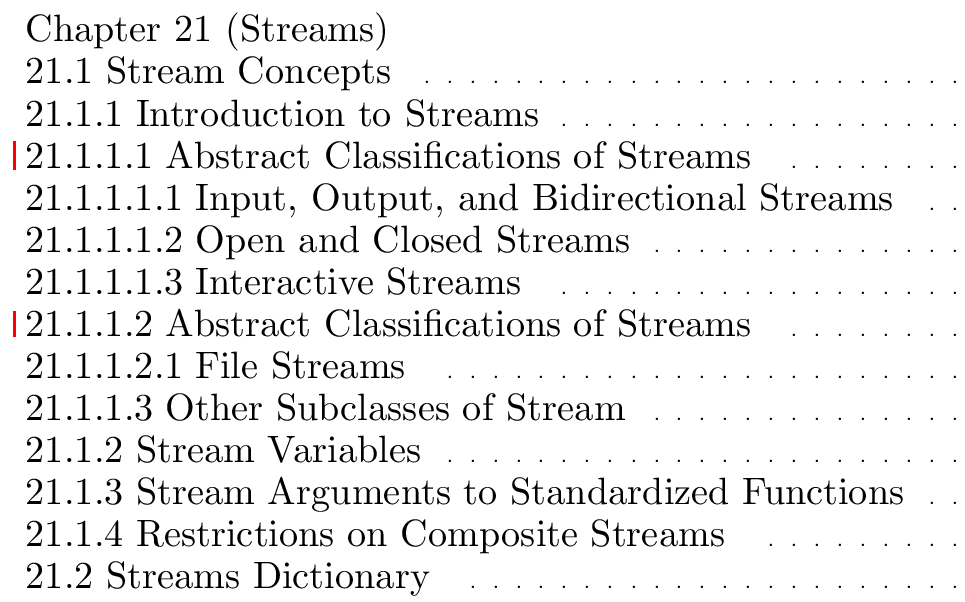
- Sections in the HyperSpec
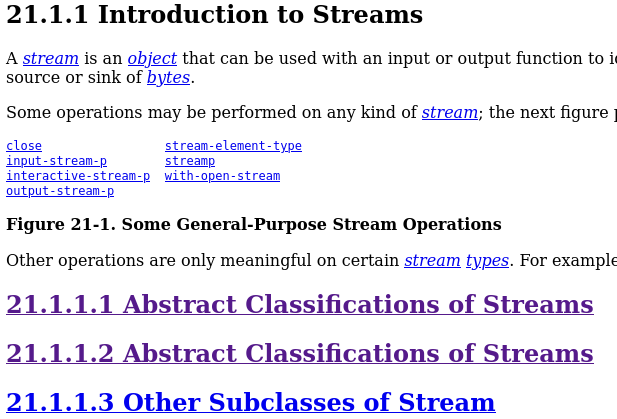
Why did this happen?
\beginsubsubsection{Abstract Classifications of Streams} [hundreds of lines] \beginsubsubsubsection{Interactive Streams} \DefineSection{InteractiveStreams} [hundreds of lines] \endsubsubsubsection%{Interactive Streams} \beginsubsubsubsection{File Streams} [hundreds of lines] \endsubsubsubsection%{File Streams} \endsubsubsection%{Abstract Classifications of Streams}
Motivation: Macro Lambda Lists
- Grammar in dpANS
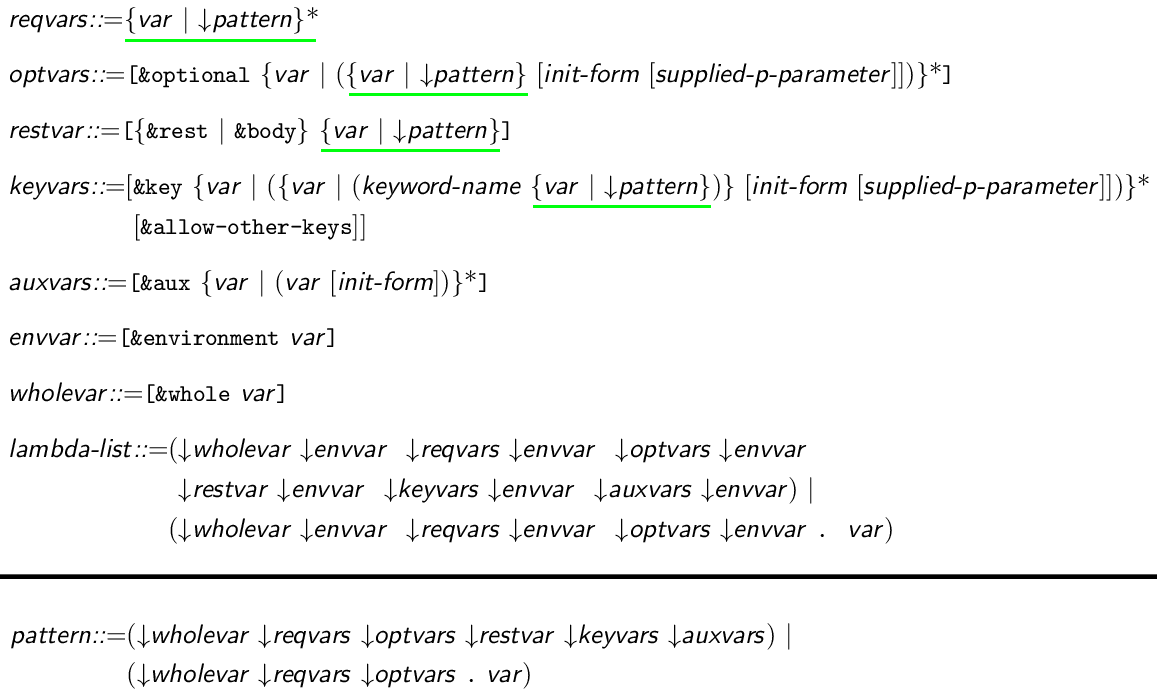
- Grammar in the HyperSpec
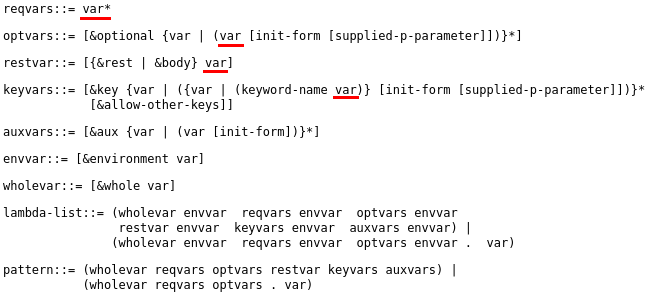
Motivation: Even TeX Wizards Make Mistakes
- dpANS TeX source
(flet ((test (x) (let ((*print-pretty* t)) (print x) (format t "~%~S " x) (terpri) (princ x) (princ " ") (format t "~%~A " x)))) (test '#'(lambda () (list "a" #\b 'c #'d)))) \OUT #'(LAMBDA () \OUT (LIST "a" #\b 'C #'D)) \OUT #'(LAMBDA () \OUT (LIST "a" #\b 'C #'D))
- Listing in dpANS
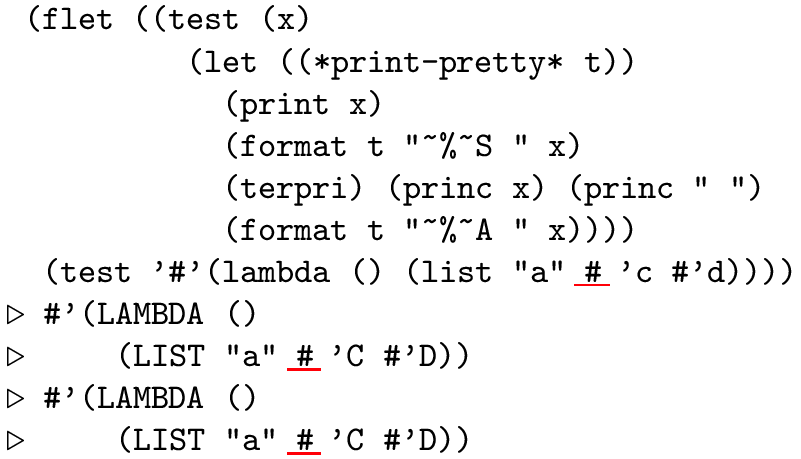
- Listing in the HyperSpec
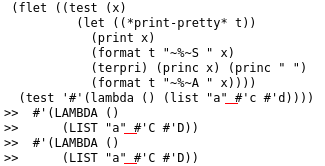
Motivation: Other Errors and Downsides
- Other errors and downsides in /dpANS/ (and thus the ANSI standard as well as the Common Lisp HyperSpec)
- No checking, highlighting or linking in listings
- Markup errors (for example
\funref{most-positive-fixnum}) - Misspelled things (for example
\macref{destruct}) - Errors that affect the semantics but have an
obvious fix (for example the famous
prog2error) - Unclear or contradictory parts of the specification, incorrect examples
- Downsides specific to the Common Lisp HyperSpec
- Legal situation: my understanding is that it is not permitted to distribute modified versions of the Common Lisp HyperSpec
- Thus compounded: The HTML conversion has been done in one particular way with respect to visual style, page granularity, indices, amount of annotations and cannot be changed
Our Method
Our Method: Overview
Document Object Tree Representation
- Example Tree
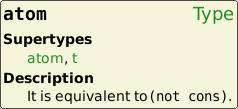
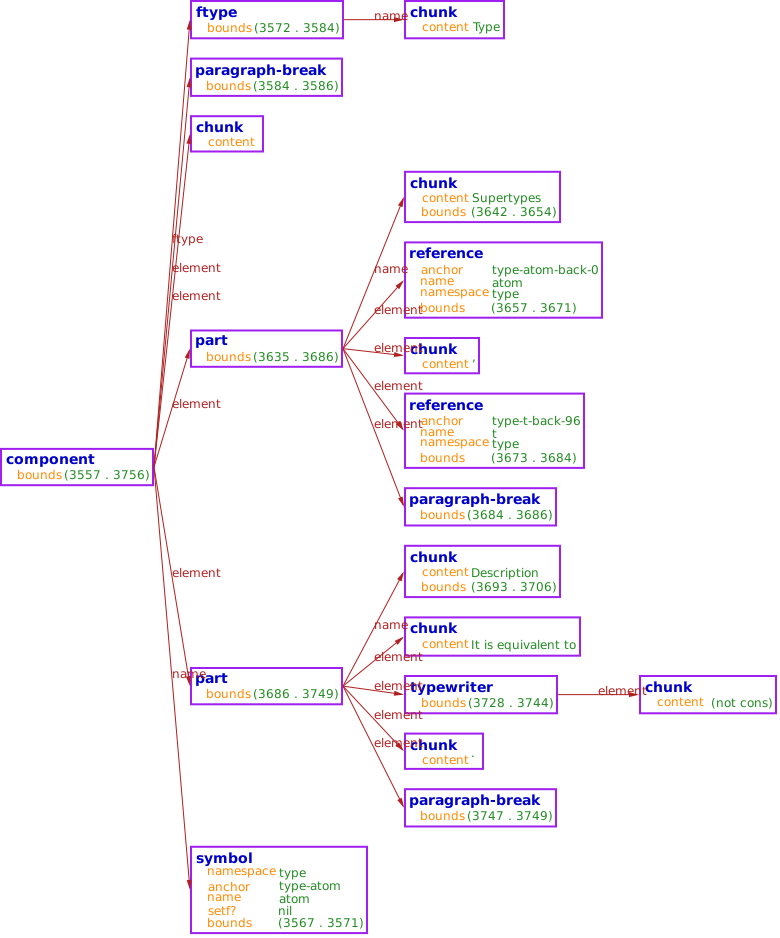
- (Meta-)Meta-model
Meta-meta-model based on architecture.builder-protocol system
Built around nodes, initargs and relations:
- Meta-model currently not specified
Our Method: TeX Parser
(defrule argument (environment)
(and (has-syntax? '#\# :argument environment)
(bounds (start end)
(seq (+ (<<- level #\#))
(<- number
(:transform
(guard digit digit-char-p)
(digit-char-p digit))))))
(bp:node* (:argument :level (length level)
:number number
:bounds (cons start
end))))
(defrule editor-note (environment)
(bounds (start end)
(seq/ws "\\editornote{"
(<- editor (person)) #\:
(<- content (balanced-content))
#\}))
(bp:node* (:editor-note :editor editor
:content content
:bounds (cons start
end))))
- Written as a set of rules for a parser generator
- Mostly recursive descent
- Rules are heavily parameterized:
- Current syntax of particular characters
- Current environment
- Defined macros
- Performs source location tracking
- Mixture of general-purpose rules for TeX and special-purpose rules for dpANS semantic and typographic markup
Our Method: TeX Parser: Example
- Input
\DefsetfMulti {bit-array {\rest} subscripts} {new-bit} {\entry{bit} \entry{sbit}}
- Document Object Tree
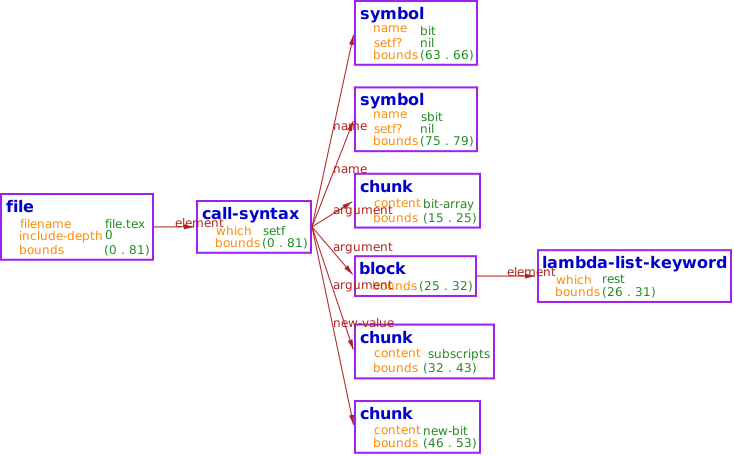
- Parser Call
(let* ((input (format nil "\\DefsetfMulti~@ {bit-array {\\rest} subscripts}~@ {new-bit}~@ {\\entry{bit} \\entry{sbit}}")) (tree (dpans-conversion.parser::parse-tex-string 'list input "file.tex"))) (render-to-file tree "images/bit-array-document-object-tree.png"))
Our Method: TeX Macro Expander
(defun expand (builder environment macro arguments) (typecase macro (function ; built-in macro (apply macro builder environment arguments)) (t ; user-level macro defined in TeX source (let* ((body (bp:node-relation* '(:body . *) macro)) (first (first (bp:node-relation* '(:argument . *) macro))) (level (if (null first-parameter) 1 (getf (bp:node-initargs* first-parameter) :level)))) (mapcar (lambda (element) (substitute-arguments builder element level arguments)) body)))))
- Macro Definition
- Represented as body ASTs containing argument nodes
- Arguments have numbers and "levels" (for macros-in-macros)
- Stored in an environment under the given name
- Represented as body ASTs containing argument nodes
- Macro Expansion
- Look up macro by name in environment
- Determine "level"
- Clone body ASTs, replacing arguments at determined "level" with supplied arguments
Our Method: TeX Macro Expander: Example
(defparameter *env* (dpans-conversion::make-environment)) (defparameter *tree* (let ((input (format nil "\\def\\foo#1#2{\\it#1 and #2}~ \\foo{a}{b}"))) (dpans-conversion.parser::parse-tex-string 'list (coerce input '(simple-array character 1)) "file.tex"))) (render-to-file *tree* "images/macro-example-original.png")
(let ((expanded (dpans-conversion.transform::apply-transform (make-instance 'dpans-conversion.transform::expand-macros :builder 'list :environment *env*) *tree*))) (render-to-file expanded "images/macro-example-expanded.png"))
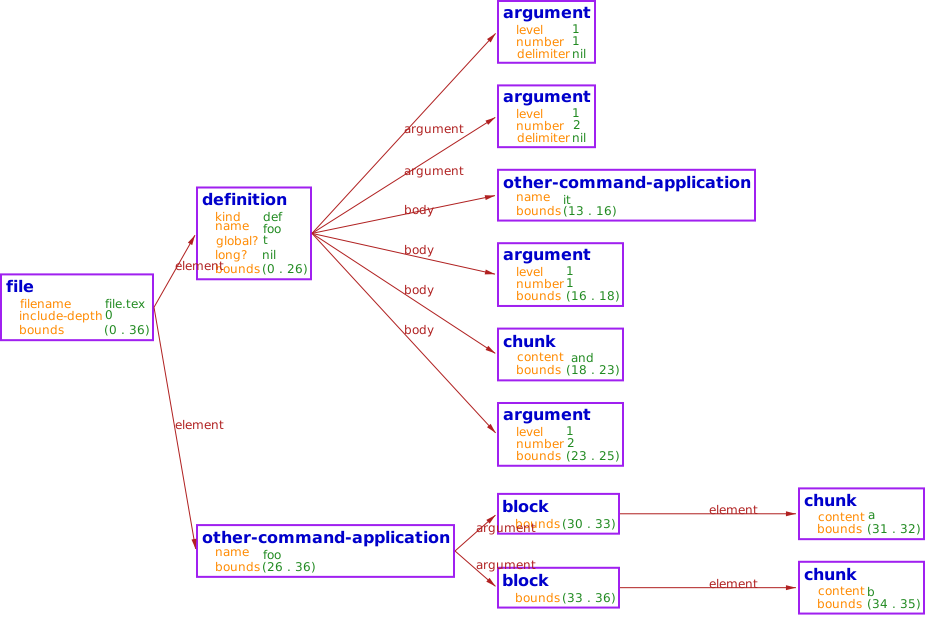
→
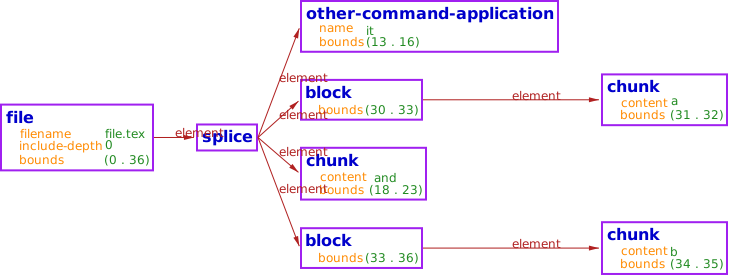
Our Method: Issue Parser
(defrule issue (filename process)
(bounds (start end)
(seq (? (<- preamble (preamble)))
(+ (or (<- name (section-name))
(<- related-issues (section-related-issues))
(<- required-issues (section-required-issues))
(<- forum (section-forum))
(<- category (section-category))
(<<- sections (section))
(seq (whitespace*) #\Newline)))))
(unless (find :proposal sections :key #'bp:node-kind*)
(cerror "Use the issue anyway" "No Proposal"))
(bp:node* (:issue :filename filename
:process process
:bounds (cons start end))
(1 (:name . 1) name)
(* (:required-issue . *) required-issues)
(* (:related-issue . *) related-issues)
(1 (:forum . 1) forum)
(1 (:category . 1) category)
(* (:section . *) (nreverse sections))
(bp:? (:preamble . bp:?) preamble)))
Demo: Document Object Tree Inspection and Queries
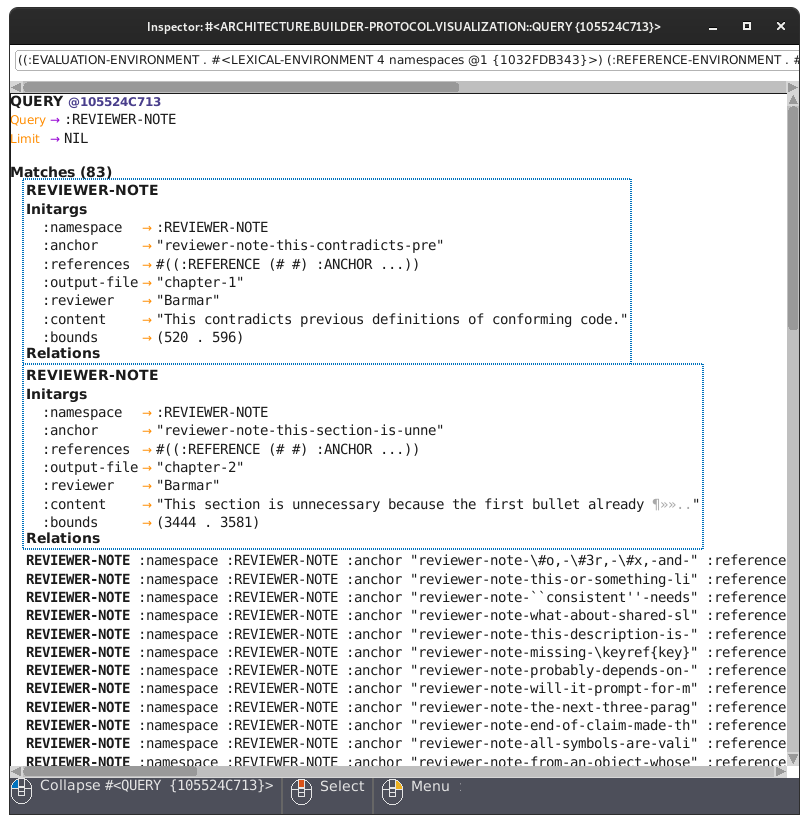
Uses previously mentioned (meta-)meta-model:
- Presentation and "folding" work as an extension for McCLIM's inspector Clouseau
- Queries are currently simplistic, but easy to extend
Our Method: (Some of the) Transformations
| Transformation | HTML | CLIM browser |
|---|---|---|
| Drop unused nodes | ✅ | ✅ |
| Parse listings | ✅ | ✅ |
| Expand macros | ✅ | ✅ |
| Massage {tables,math,comp.,issues} | ✅ | ✅ |
| Attach labels | ✅ | ✅ |
| Add dictionary sections | ✅ | ❌ |
| Split into files | ✅ | ❌ |
| {symbol,table,issue,note} index | ✅ | ❌ |
| Note output files | ✅ | ❌ |
| Note parents | ❌ | ✅ |
| Build references | ✅ | ✅ |
| Render | HTML | CLIM |
Our Method: Syntax Highlighting
- Goal
\def\alfa{$\alpha$} \code (alpha-char-p #\\a) \EV \term{true} (alpha-char-p #\\5) \EV \term{false} (alpha-char-p #\\Newline) \EV \term{false} ;; This next example presupposes ;; an implementation in which ;; #\\\alfa is a defined character. (alpha-char-p #\\\alfa) \EV \term{implementation-dependent} \endcode
↓

- Solution
- Parse listings using Eclector
- Within symbols, strings, character literals, comments, etc.
- Recognize TeX macros
- Expand TeX macros
- Output
- Non-macro parts of input with highlighting
- Skip over macros parts of input
- Splice macro expansion into output
Our Method: HTML Generation
- Decisions and Parameters
- MathJax vs. MathML
- Require Javascript?
- Styling (CSS)
- Table of contents
- None
- Static
- Dynamic Sidebar (requires Javascript)
- Permalinks
- Annotations (via Hover?)
- Search (via Javascript?)
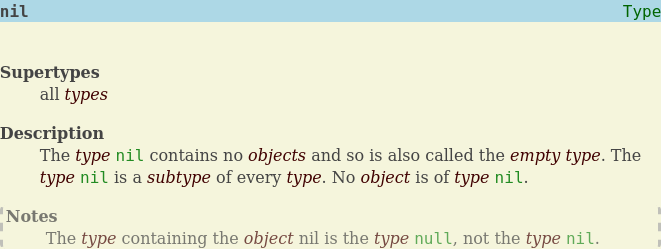
(define-render (:part) (let ((name (transform::node-name node))) (flet ((do-it () (cxml:with-element "dl" (cxml:with-element "dt" (class-attribute "label") (recurse '(:name . 1))) (cxml:with-element "dd" (recurse '(:element . *)))))) (maybe-removable-text transform name #'do-it :removable '("Note" "Example" "Pronunciation" "See Also")))))
Demo: Parsing and Generating
- Run the parser
- Perform transformations
- Macro expansion
- …
- Generate HTML
Applications
Demo: HTML Output
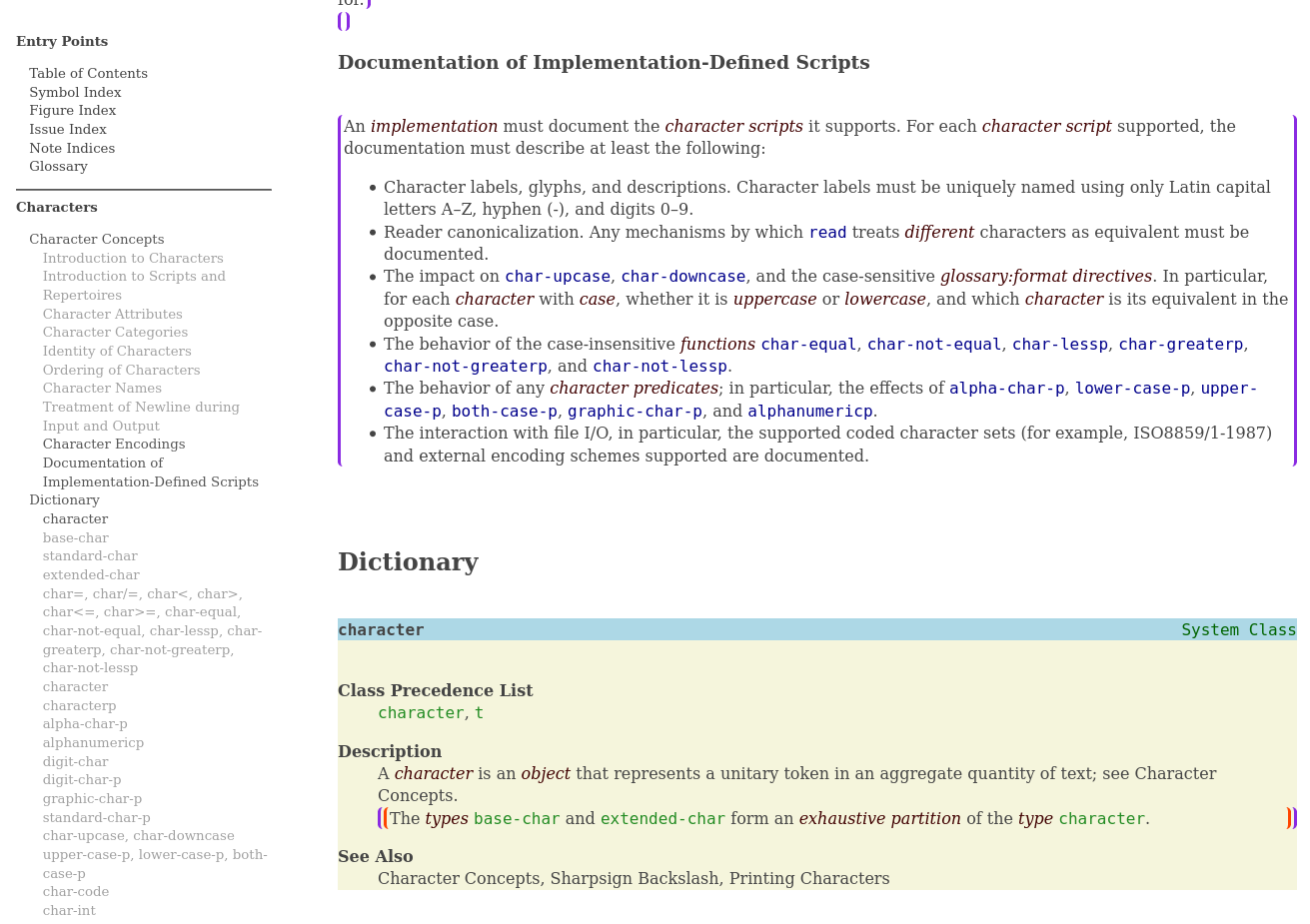
- Math
- Syntax Highlighting
- Sidebar
- Generated Indices
- Annotations
Demo: CLIM-based Specification Browser

- McCLIM-based graphical specification browser
- Directly renders document object tree
- Can show/hide aspects on the fly, such as
- X3J13 issue annotations
- Reviewer notes
- Editor notes
- The removable text indication
- Not yet supported
- Search
- Automatic indices
- Navigation history
Application: Concurrency Specification

- Extension for well-specified concurrency:
- Rules for concurrent evaluations (related: a memory model)
- Threads, locks, condition variables
- Atomic operations
- Interrupts
- Written by Bike, see GitHub repository
- Adds new
- Chapter
- Concept Sections
- Dictionary Section
Open Problems and Future Work
Problem: Simple Matters of Programming™
- Clean up conversion code
- Line breaks in call syntax and BNFs
- Figure captions
- Local macro definitions
- hbox
- Non-section link anchors
- Is XHTML with MathML a sane choice? HTML5 with MathJax didn't work so well
- …
Problem: How to Ensure Correctness?
- We probably cannot ensure correctness
- We can make sure to fix things that
- are known to be wrong in the dpANS sources
- that the Common Lisp HyperSpec conversion got wrong
- But how can we catch new conversion errors that we introduce?
Problem: Stemming Algorithm for Glossary
- Problem
- References to glossary entries are very free-form (in terms of numerus, conjugation, grouping of words that individually have glossary entries)
- Examples
\term{evaluates},\term{evaluated}must refer to the "evaluate" entry\term{satisfying the test},\term{satisfies the test}must refer to "satisfy the test" entry
- Possible Solutions
- Hack some good enough stemming
- Maybe some tables for exceptions?
- I have tried this with limited success
- Implement a proper stemming algorithm (or use some database)
- Hack some good enough stemming
How did Kent Pitman do it for the Common Lisp HyperSpec back in the day?
Problem: Are Final Versions of X3J13 Issues Available Anywhere?
- We are currently using X3J13 issue text files obtained from http://www.cs.cmu.edu/afs/cs/project/ai-repository/ai/lang/lisp/doc/standard/ansi/cleanup/
- The Common Lisp HyperSpec has been made with a more complete and more recent
collection of X3J13 issues. For example:
- The issue CHARACTER-VS-CHAR is missing from the above archive
For DEFSTRUCT-COPIER, the above archive has the versions
V1, 10 May 90, Sandra Loosemore V2, 13 May 90, Sandra Loosemore (update discussion) V3, 29 May 90, Sandra Loosemore (more comments)
but not
07-Jul-93, Version 1 by Pitman
If you have access to more recent versions of the X3J13 issues, please contact us!
To be continued …
Part II will cover
- dpANS
- Modifications to dpANS we already made (don't worry they are all cosmetic)
- How we track modifications to dpANS
- Well-Specified Common Lisp
- The goal of Well-Specified Common Lisp
- Writing issues for Well-Specified Common Lisp
- A process for approving and applying Well-Specified Common Lisp issues
- Other specifications and extensions
Thank You for Your Attention!
- This Presentation
- https://techfak.de/~jmoringe/presentation-dpans-conversion/slides.html
- IRC Channels
#dpanson the libera IRC network for dpANS parsing and conversion#commonlispon the libera IRC network for discussions about new issues, specification changes and Well-Specified Common Lisp
- Code